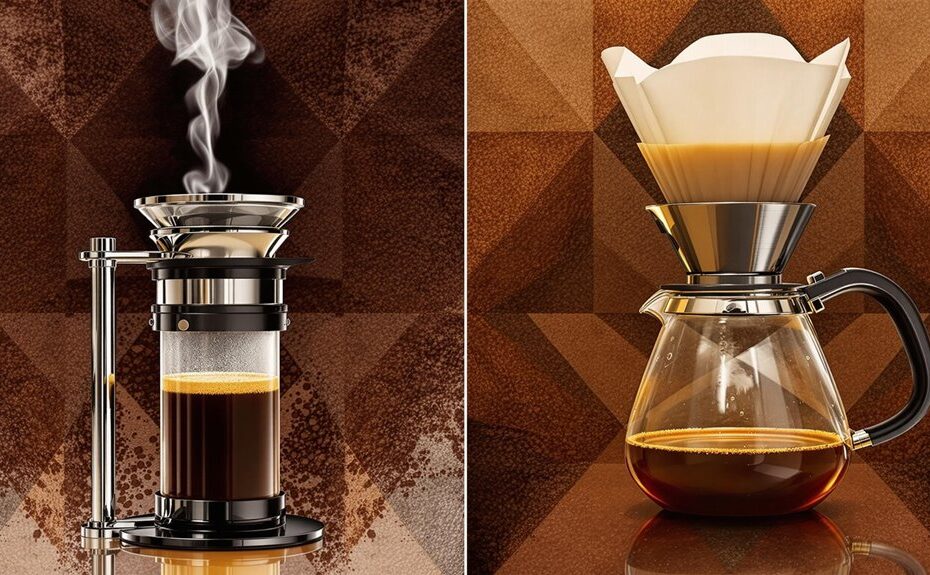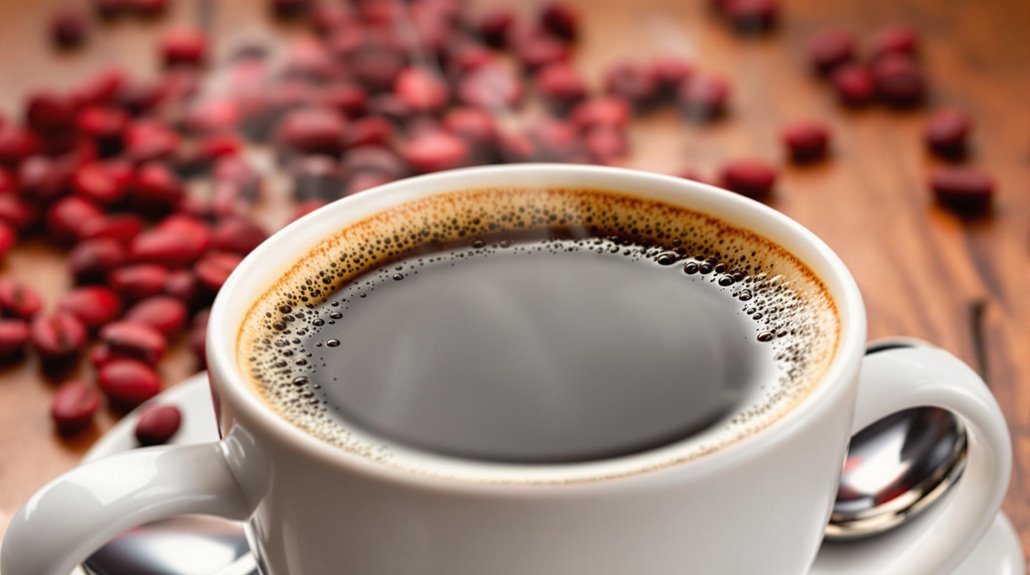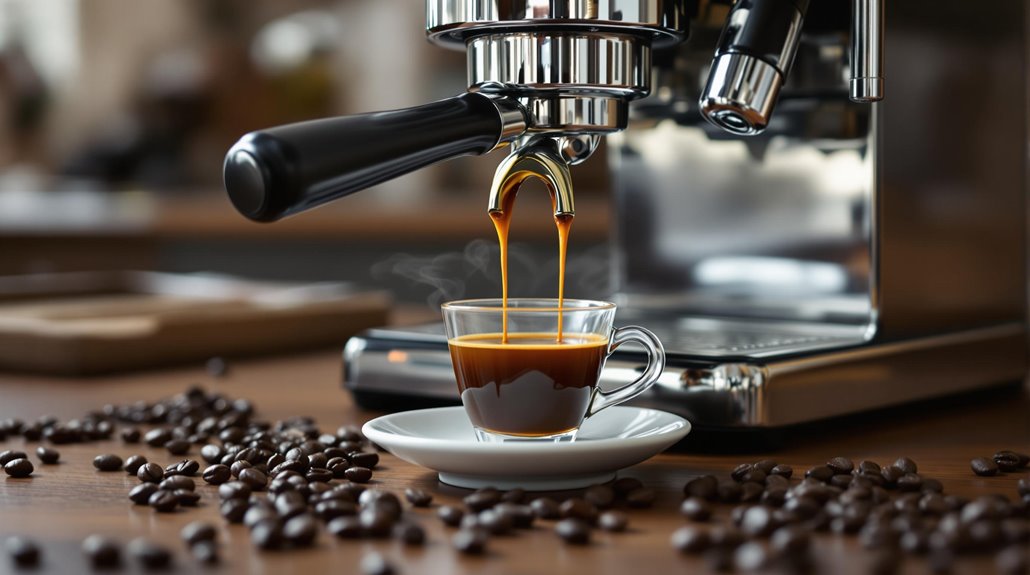




Imagine the rich aroma of freshly brewed coffee filling your kitchen as you weigh the distinct methods of brewing with an AeroPress versus a drip coffee maker. You might find yourself considering not just the taste, but also how each method influences your morning routine. While AeroPress delivers a concentrated shot of flavor, drip coffee offers a smooth, balanced cup. What do these differences mean for your coffee experience, and which method aligns with your preferences? The answers might surprise you as you explore the nuances between these two popular brewing techniques.
Key Takeaways
- AeroPress brews coffee using air pressure, while drip coffee machines rely on gravity for extraction.
- The AeroPress offers bold, concentrated flavors similar to espresso, whereas drip coffee produces a smoother, balanced profile.
- AeroPress has a faster brewing time (30 seconds to 4 minutes) compared to drip coffee machines, which take 5 to 10 minutes.
- AeroPress is portable and can brew without electricity, while drip coffee machines require a power source.
- AeroPress allows for more experimentation with grind size and brew time, whereas drip machines provide consistent volume for multiple servings.
Brewing Methods Comparison
When it comes to brewing methods, the AeroPress and drip coffee machines present distinct experiences that cater to different preferences and needs. The AeroPress utilizes air pressure to force hot water through coffee grounds, allowing for a quicker brewing time of just 30 seconds to 4 minutes. This method encourages experimentation with grind size, brew time, and water-to-coffee ratio, giving you control over the extraction process and resulting in a concentrated flavor reminiscent of espresso.
In contrast, drip coffee machines rely on gravity, producing a smoother, more balanced cup over a longer brewing time of 5 to 10 minutes. The use of coffee filters in drip coffee absorbs oils and fine particles, resulting in a cleaner, lighter body that appeals to those preferring subtler flavors. While you can brew a maximum of 10 ounces at a time with the AeroPress, drip coffee makers shine when it comes to larger groups, brewing multiple cups simultaneously. Ultimately, your choice between these methods will depend on your desired flavor profile, brewing time, and how much control you want over the brewing process.
Flavor Profiles and Taste

When you brew coffee with an AeroPress, the air pressure extracts bold flavors and oils, creating a concentrated cup that hits your palate with intensity. In contrast, drip coffee's gravity-based method results in a smoother, more balanced profile, allowing delicate notes to shine through without overwhelming your senses. Understanding these differences in brewing methods can profoundly influence your coffee experience, shaping your preference for either the richness of AeroPress or the subtleties of drip coffee.
Brewing Method Impact
The brewing method you choose greatly impacts the flavor profile and taste of your coffee. With the AeroPress, you harness air pressure to push hot water through coffee grounds, achieving a concentrated flavor profile akin to espresso. This quick extraction, typically between 30 seconds and 4 minutes, often results in a stronger cup with higher caffeine content. In contrast, drip coffee relies on gravity, taking 5 to 10 minutes to brew, producing a smoother, more balanced taste.
The grind size plays an essential role, too. AeroPress uses a medium-fine grind that amplifies flavor intensity, while drip coffee generally calls for a medium-coarse grind to promote even extraction and consistency. The choice of filters further influences the final taste; AeroPress allows for both paper and metal filters, which can let through more oils for a richer flavor. Drip coffee's paper filters, however, yield a cleaner, lighter-bodied cup.
Ultimately, your taste preferences will guide your choice. Whether you lean towards the bold richness of AeroPress or the subtle complexities of drip coffee, the brewing method undeniably shapes your coffee experience.
Flavor Intensity Comparison
Flavor intensity markedly distinguishes the AeroPress from drip coffee, shaping the overall tasting experience. With its pressure-based extraction method, the AeroPress often produces a stronger, more concentrated cup, akin to espresso. This robust flavor profile is enhanced by your ability to manipulate brewing variables like grind size and steeping time, allowing for a truly personalized brew.
Conversely, drip coffee presents a smoother, more balanced flavor profile. While it may lack the punch of an AeroPress, the longer brewing time reveals subtle notes that can be a delight for those who appreciate nuanced tastes. The paper filters used in drip coffee absorb some of the oils, resulting in a milder flavor that some might prefer.
Ultimately, taste preferences vary widely. You might lean towards the boldness and richness of AeroPress coffee, appreciating its higher oil extraction, or you may find yourself drawn to the classic, gentle nuances of drip coffee. Whichever method you choose, the flavor intensity will considerably impact your overall coffee experience, making it essential to select the brewing method that aligns with your palate.
Filter Options and Effects
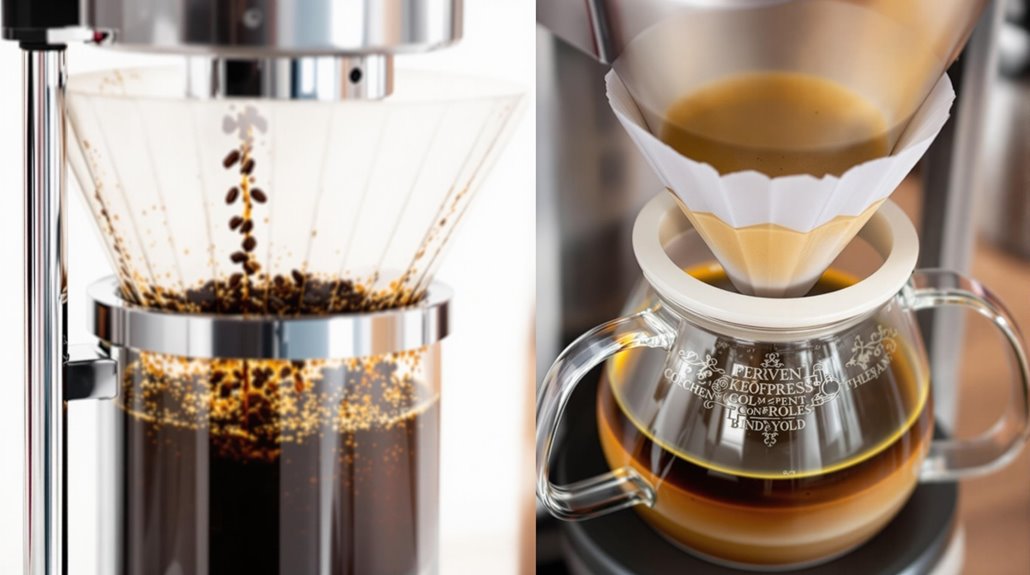
Choosing the right filter can dramatically affect your coffee experience, especially when comparing the AeroPress and drip coffee methods. The AeroPress mainly uses paper filters, which trap oils and fine particles, resulting in a clean cup with lighter body and subtle flavors. In contrast, drip coffee mainly employs paper filters, but if you opt for a metal filter, you can allow more oils to pass through, creating a richer, fuller-bodied coffee.
The choice of filter type greatly impacts coffee clarity, texture, and overall quality. With the AeroPress, you can experiment with both paper and metal filters to adjust your flavor profile, delving into a world of coffee richness akin to a French Press. Drip coffee, however, typically sticks to a single filter type, limiting your options unless you incorporate a reusable filter.
Moreover, consider the environmental waste factor. While both brewing methods use paper filters, the AeroPress offers reusable metal and cloth options, reducing waste over time. By understanding these filter options and their effects, you can enhance your brewing methods and elevate your coffee experience.
Cost and Versatility
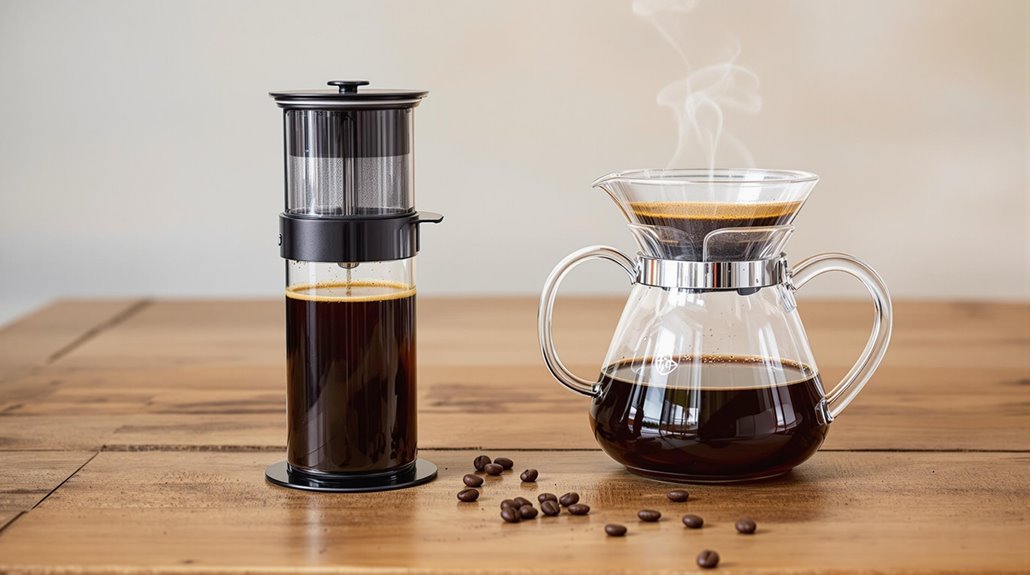
Although both the AeroPress and drip coffee makers serve the same ultimate purpose of brewing coffee, they diverge greatly in cost and versatility, making each a unique choice for different brewing preferences. The AeroPress is incredibly cost-effective, priced at around $30, whereas drip coffee makers can range from $20 to over $100. This price difference can greatly impact your budget, especially if you're a coffee enthusiast.
In terms of versatility, the AeroPress shines, allowing you to experiment with various brewing methods, grind sizes, water temperatures, and brewing times. This creative freedom is something drip coffee makers lack, as they typically rely on automated settings that limit your options.
Moreover, the AeroPress is portable and lightweight, making it ideal for travel or outdoor adventures, while drip coffee makers tend to be bulkier and require an electrical outlet. Although the AeroPress brews a single cup at a time, you can easily adjust its capacity to meet your needs. Plus, the ongoing costs can be lower with reusable filters, unlike the continuous expense of disposable paper filters for drip coffee makers. Ultimately, each option caters to different lifestyles and preferences.
User-Friendliness and Maintenance
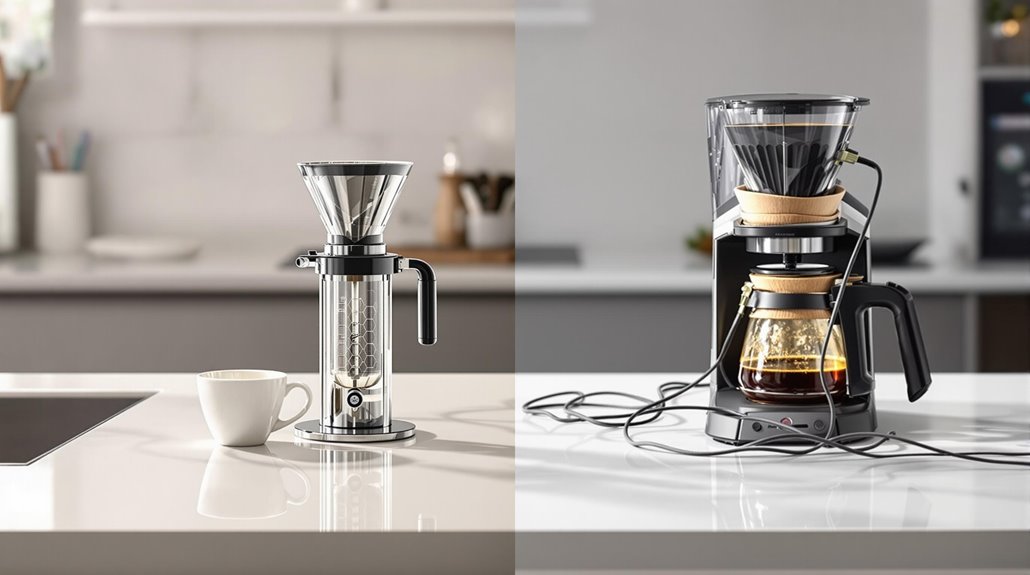
When it comes to user-friendliness and maintenance, the AeroPress stands out for its simplicity and efficiency. You'll appreciate its ease of use, as it requires just a few straightforward steps to brew a perfect cup of coffee. In contrast, while drip coffee machines may offer an automated brewing process, they often come with complicated setups and programming that can be frustrating.
Cleanup with the AeroPress is another significant advantage. You'll spend about three minutes rinsing the components, making it an incredibly efficient choice. Drip coffee machines, on the other hand, demand more effort due to multiple parts and the potential for stubborn coffee residue.
The AeroPress is also compact and portable, making it perfect for travel or outdoor adventures, while drip coffee machines are bulkier and primarily designed for home use. Both methods are user-friendly, but the AeroPress provides greater flexibility for experimenting with grind size and brew time, catering to diverse coffee preferences. Additionally, with the option of reusable filters, the AeroPress typically incurs lower ongoing costs compared to drip coffee machines that rely on disposable paper filters.
Popular Uses and Scenarios
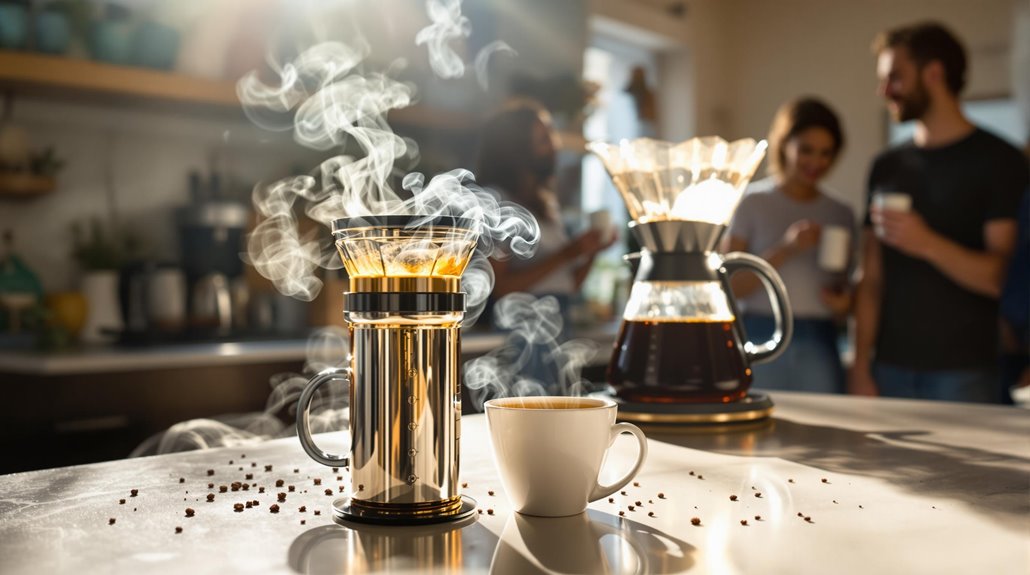
In various settings, the AeroPress and drip coffee makers cater to distinct needs and preferences, each shining in their own right. If you're an avid camper or someone who enjoys outdoor activities, the AeroPress is a game changer. Its compact design and lightweight construction allow you to brew delicious coffee quickly, even without electricity. You can experiment with various brewing methods, creating a personalized coffee experience that excites any coffee enthusiast.
On the other hand, if you're into home brewing, especially in larger households, drip coffee makers are your go-to. They easily brew multiple cups—ranging from 2 to 12 or more—making them ideal for gatherings or busy mornings. Plus, their programmable features let you set a brewing schedule in advance, so you can wake up to the rich aroma of fresh coffee.
While the AeroPress offers immediate satisfaction, perfect for a quick caffeine fix while camping, drip coffee machines provide a slower, more traditional brewing ritual. Depending on your scenario, whether it's a campsite or your kitchen, each method enhances your coffee journey in unique ways.
Disclosure: As an Amazon Associate, I earn from qualifying purchases.
